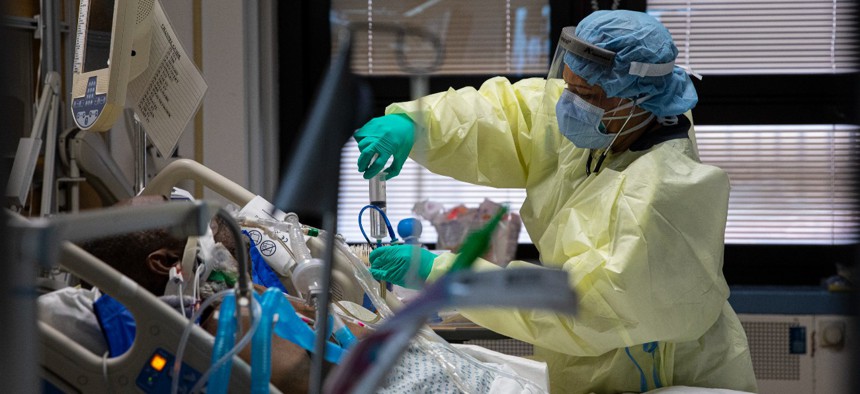
A nurse puts fluids into the feeding tube of a COVID-19 patient at the Medical Intensive Care Unit floor at the Veterans Affairs Medical Center in New York City in April 2020. Robert Nickelsberg/Getty Images
VA Sees Spike in COVID-19 Deaths Among Employees in August
"Oh no, here we go again," employees say of current conditions at VA facilities.
Veterans Affairs Department employees have in August seen a tripling of COVID-19-related deaths compared to recent months, with 15 employees so far succumbing to the virus.
As hospitals around the country face a surge of coronavirus cases stemming from the delta variant, VA is cautioning its employees and offering services to help them deal with grief. Nearly 1,200 department employees have active cases, approaching the totals VA experienced over the winter during the pandemic’s worst peak thus far. A total of 172 VA workers have died from symptoms related to COVID-19. Between March and July, VA had experienced one-to-four employees deaths per month, but that figure has spiked in recent weeks.
VA has “continued to see surging numbers of COVID and staff calling out sick and sadly, we’ve lost more staff than we ever have in a month before from COVID,” Steven Lieberman, acting undersecretary for health, said in a message that went out to all Veterans Health Administration employees on Thursday. A VA spokesman later clarified that Lieberman misspoke, as more employees passed away from COVID-19 in January.
Lieberman encouraged staff to reach out to colleagues who are grieving and to take advantage of resources such as VA’s employees assistance program.
“It’s very upsetting to all of us,” Lieberman said. “I know if you know a coworker that you’ve lost, I’m sure it’s been a very sad and troubling experience to go through that.”
One VA nurse in Ohio told Government Executive her facility is seeing younger and sicker COVID019 patients, who more frequently than previous surges require extended stays in the hospital. Her emergency room is “overflowing,” she said, and other, non-VA ERs are also full so her facility cannot transfer patients out as it normally would. Systemwide, VA currently has nearly 14,000 active cases.
“It’s almost like ‘oh no, here we go again,’” the nurse said. “I think people were finally starting to see light at the end of the tunnel and this came roaring back.”
While VA as a whole is not experiencing the same personal protective equipment and testing shortages it saw early in the pandemic, the Ohio nurse said there is “room for improvement always.” She added her facility is understaffed, noting management has instituted mandatory overtime.
National Nurses United, which represents some VA employees, said in a statement that hospital systems like VA were creating a cycle in which staffing shortages would persist indefinitely.
A “simple and effective solution” to the problem, the union said, is to “ensure safe and optimal working conditions for nurses, including sufficient numbers of nursing staff on every shift, and implementing all the multiple measures of infection control that nurses need to protect themselves and their patients.”
A VA nurse in Colorado said her facility’s intensive care unit is filling up, largely with those who are unvaccinated.
“This last week has been bad, and it doesn’t seem to be getting better,” the nurse said.
VA has issued a COVID-19 vaccine mandate for about 360,000 employees who either provide direct patient care or are around those who do. Those employees have until either late-September or mid-October to receive their shots if they have not already done so. The department is allowing for religious or medical exemptions, but those without one who do not receive the vaccine may face discipline. Many VA employees Government Executive has spoken to have voiced apprehension about the mandate, with some workers saying they will leave the department rather than get inoculated.
Lieberman said there is cause for optimism, as vaccination rates have picked up both among veteran patients and VA staff. He added there are “glimmers of hope” the department will fare better in September than it has this month, as in some parts of the country VA is “starting to turn the corner on this surge.” Lieberman ended his message by offering his gratitude to the VA workforce.
“I am just so in awe of the work that our staff does, how resilient you are, how hard you work to ensure the veterans we serve receive the best care anywhere,” he said.
NEXT STORY: How Zoom Messed up Access for Disabled Users







